What Came After Windows Vista
Microsoft Windows has seen nine major versions since its start release in 1985. Over 29 years later, Windows looks very dissimilar merely somehow familiar with elements that have survived the examination of time, increases in computing power and – most recently – a shift from the keyboard and mouse to the touchscreen.
Hither'southward a cursory look at the history of Windows, from its nascence at the hands of Bill Gates with Windows one to the latest inflow under new Microsoft master executive Satya Nadella.
Windows 1
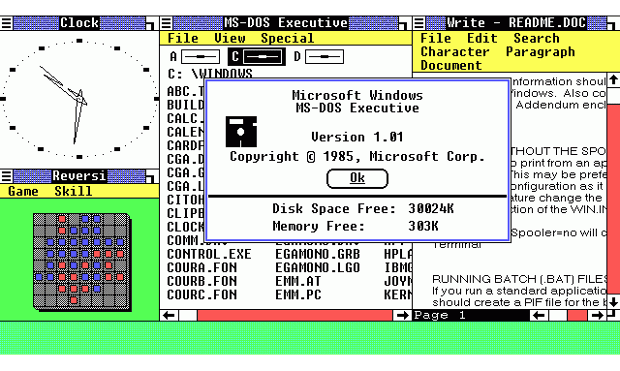
This is where it all started for Windows. The original Windows 1 was released in Nov 1985 and was Microsoft's offset true endeavor at a graphical user interface in 16-scrap.
Evolution was spearheaded by Microsoft founder Neb Gates and ran on summit of MS-DOS, which relied on control-line input.
It was notable because it relied heavily on use of a mouse before the mouse was a common computer input device. To assist users become familiar with this odd input system, Microsoft included a game, Reversi (visible in the screenshot) that relied on mouse control, not the keyboard, to become people used to moving the mouse around and clicking onscreen elements.
Windows 2
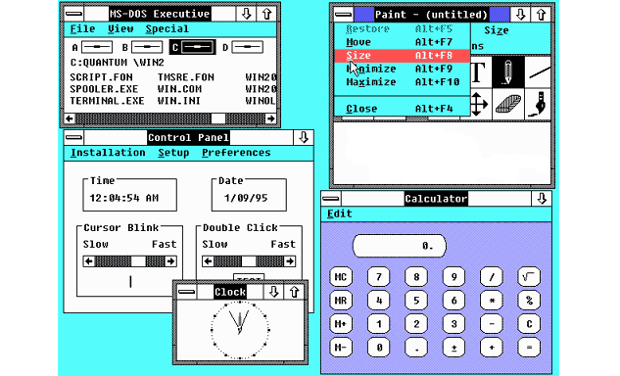
Two years after the release of Windows 1, Microsoft'due south Windows 2 replaced it in December 1987. The big innovation for Windows 2 was that windows could overlap each other, and information technology besides introduced the ability to minimise or maximise windows instead of "iconising" or "zooming".
The control console, where diverse system settings and configuration options were collected together in 1 place, was introduced in Windows 2 and survives to this twenty-four hour period.
Microsoft Word and Excel likewise fabricated their start appearances running on Windows 2.
Windows iii

The first Windows that required a hard drive launched in 1990. Windows 3 was the beginning version to run into more than widespread success and exist considered a challenger to Apple'due south Macintosh and the Commodore Amiga graphical user interfaces, coming pre-installed on computers from PC-compatible manufacturers including Zenith Data Systems.
Windows 3 introduced the ability to run MS-DOS programmes in windows, which brought multitasking to legacy programmes, and supported 256 colours bringing a more than mod, colourful look to the interface.
More important - at least to the sum full of human time wasted - it introduced the card-moving timesink (and mouse employ trainer) Solitaire.
Windows 3.1
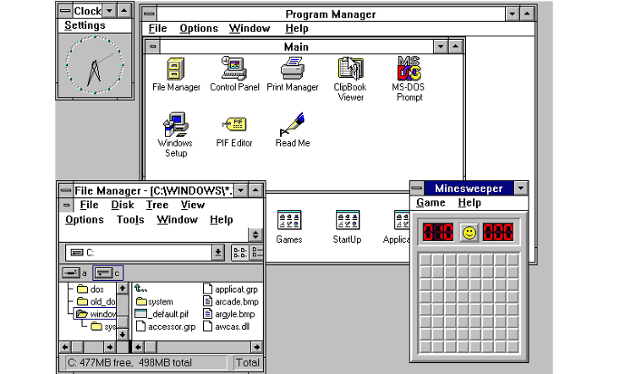
Windows 1 and 2 both had point release updates, but Windows 3.1 released in 1992 is notable considering it introduced TrueType fonts making Windows a viable publishing platform for the first fourth dimension.
Minesweeper also made its first appearance. Windows 3.1 required 1MB of RAM to run and immune supported MS-DOS programs to be controlled with a mouse for the first fourth dimension. Windows 3.1 was also the offset Windows to be distributed on a CD-ROM, although one time installed on a difficult drive it merely took up x to 15MB (a CD can typically store upwards to 700MB).
Windows 95

As the proper name implies, Windows 95 arrived in August 1995 and with it brought the first ever Start button and Start menu (launched with a gigantic advert campaign that used the Rolling Stones' Start Me Upwardly, and a couple of months after Friends stars Jennifer Aniston and Matthew Perry. Could it be whatsoever more up-to-date?)
Information technology besides introduced the concept of "plug and play" – connect a peripheral and the operating arrangement finds the appropriate drivers for it and makes information technology work. That was the idea; it didn't always work in practice.
Windows 95 also introduced a 32-bit surroundings, the chore bar and focused on multitasking. MS-DOS yet played an important role for Windows 95, which required information technology to run some programmes and elements.
Internet Explorer likewise made its debut on Windows 95, but was not installed past default requiring the Windows 95 Plus! pack. Later on revisions of Windows 95 included IE by default, equally Netscape Navigator and NCSA Mosaic were pop at the time.
Windows 98

Released in June 1998, Windows 98 built on Windows 95 and brought with information technology IE 4, Outlook Express, Windows Address Volume, Microsoft Chat and NetShow Player, which was replaced past Windows Media Player 6.2 in Windows 98 Second Edition in 1999.
Windows 98 introduced the dorsum and forward navigation buttons and the address bar in Windows Explorer, among other things. One of the biggest changes was the introduction of the Windows Driver Model for calculator components and accessories – ane driver to back up all futurity versions of Windows.
USB back up was much improved in Windows 98 and led to its widespread adoption, including USB hubs and USB mice.
Windows ME
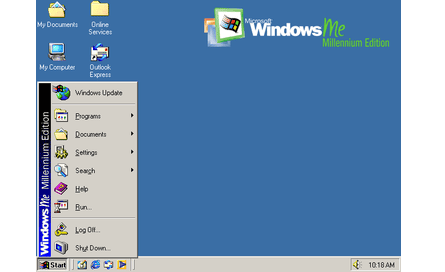
Considered a low point in the Windows serial past many – at to the lowest degree, until they saw Windows Vista – Windows Millennium Edition was the terminal Windows to be based on MS-DOS, and the concluding in the Windows 9x line.
Released in September 2000, information technology was the consumer-aimed operating system twined with Windows 2000 aimed at the enterprise market place. Information technology introduced some important concepts to consumers, including more automated system recovery tools.
IE 5.v, Windows Media Player 7 and Windows Movie Maker all fabricated their appearance for the beginning time. Autocomplete besides appeared in Windows Explorer, only the operating organisation was notorious for being buggy, failing to install properly and being generally poor.
Windows 2000
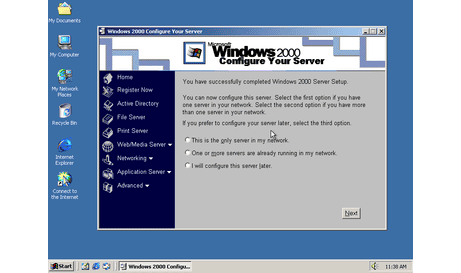
The enterprise twin of ME, Windows 2000 was released in February 2000 and was based on Microsoft'southward business-orientated organization Windows NT and subsequently became the basis for Windows XP.
Microsoft's automatic updating played an of import role in Windows 2000 and became the first Windows to back up hibernation.
Windows XP
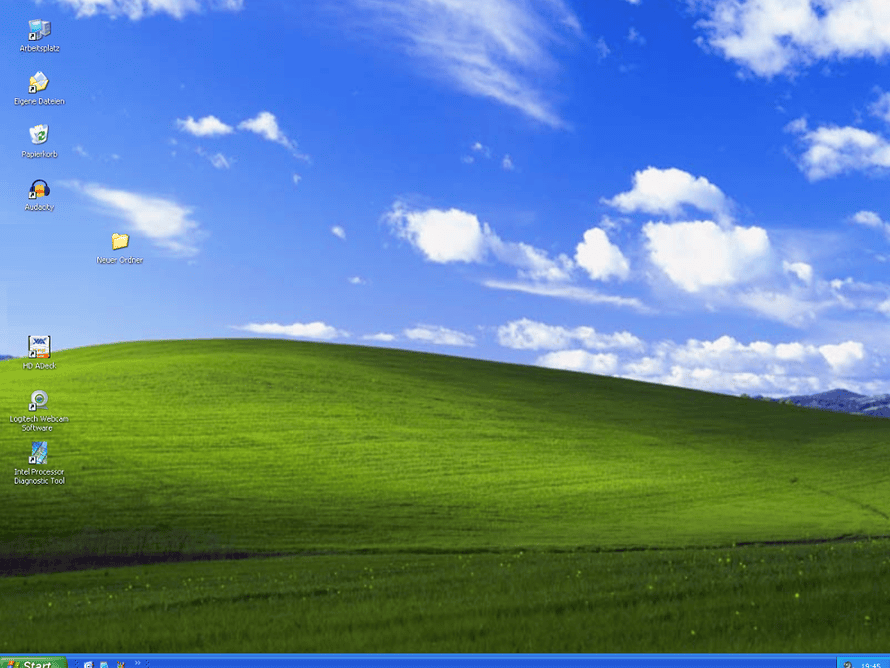
Arguably one of the best Windows versions, Windows XP was released in October 2001 and brought Microsoft'south enterprise line and consumer line of operating systems under one roof.
Information technology was based on Windows NT like Windows 2000, but brought the consumer-friendly elements from Windows ME. The Starting time menu and task bar got a visual overhaul, bringing the familiar dark-green Start button, blueish job bar and vista wallpaper, forth with various shadow and other visual furnishings.
ClearType, which was designed to make text easier to read on LCD screens, was introduced, equally were built-in CD called-for, autoplay from CDs and other media, plus various automated update and recovery tools, that different Windows ME actually worked.
Windows XP was the longest running Microsoft operating system, seeing iii major updates and support up until Apr 2014 – 13 years from its original release engagement. Windows XP was nonetheless used on an estimated 430m PCs when it was discontinued.
Its biggest problem was security: though information technology had a firewall built in, it was turned off past default. Windows XP'due south huge popularity turned out to exist a boon for hackers and criminals, who exploited its flaws, peculiarly in Internet Explorer, mercilessly - leading Bill Gates to initiate a "Trustworthy Computing" initiative and the subsequent issuance of to Service Pack updates that hardened XP against attack essentially.
Windows Vista

Windows XP stayed the course for close to six years before being replaced by Windows Vista in January 2007. Vista updated the expect and feel of Windows with more focus on transparent elements, search and security. Its development, under the codename "Longhorn", was troubled, with ambitious elements abandoned in club to become it into production.
It was buggy, burdened the user with hundreds of requests for app permissions nether "User Account Control" - the result of the Trustworthy Computing initiative which now meant that users had to corroborate or disapprove attempts by programs to make various changes. The problem with UAC was that it led to self-approbation, with people clicking "yes" to almost annihilation - taking security back to the pre-UAC country. Information technology too ran slowly on older computers despite them existence deemed as "Vista Ready" - a labelling that saw it sued considering not all versions of Vista could run on PCs with that label.
PC gamers saw a boost from Vista's inclusion of Microsoft'due south DirectX 10 technology.
Windows Media Player 11 and IE 7 debuted, along with Windows Defender an anti-spyware programme. Vista also included speech recognition, Windows DVD Maker and Photo Gallery, every bit well as being the commencement Windows to be distributed on DVD. Later a version of Windows Vista without Windows Media Thespian was created in response to anti-trust investigations.
Windows 7
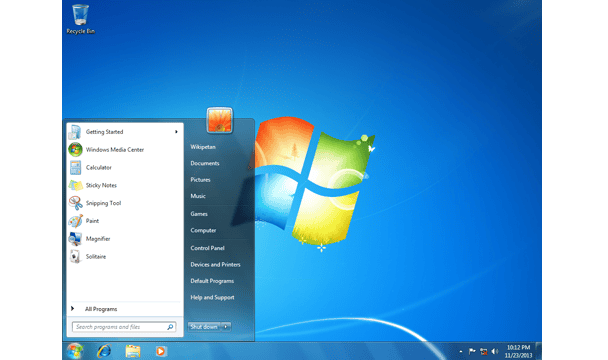
Considered by many as what Windows Vista should have been, Windows 7 was first released in October 2009. Information technology was intended to set up all the problems and criticism faced past Vista, with slight tweaks to its appearance and a concentration on user-friendly features and less "dialogue box overload".
It was faster, more stable and easier to use, becoming the operating organization most users and business concern would upgrade to from Windows XP, forgoing Vista entirely.
Handwriting recognition debuted in seven, as did the ability to "snap" windows to the tops or sides of the screen, allowing faster more automatic window resizing.
Windows 7 saw Microsoft hit in Europe with antitrust investigations over the pre-installing of IE, which led to a browser ballot screen existence shown to new users allowing them to cull, which browser to install on first boot.
Windows 8
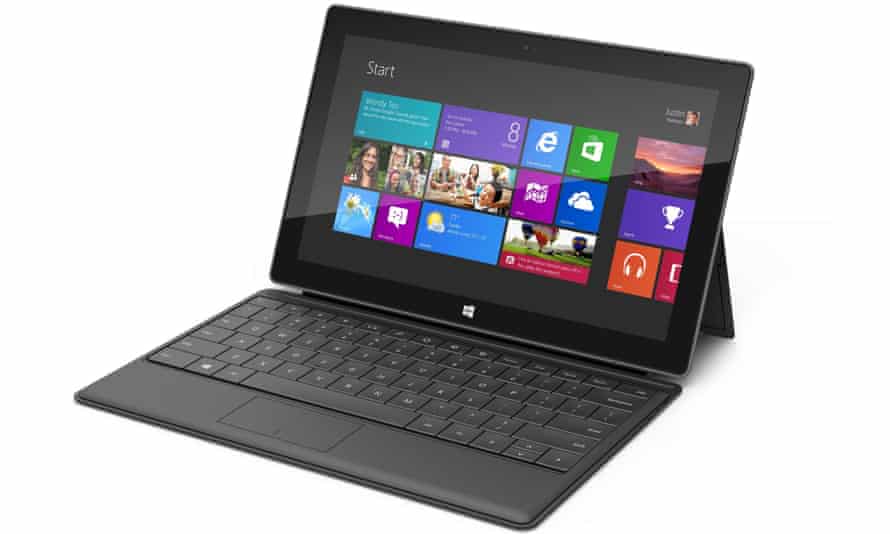
Released in October 2012, Windows viii was Microsoft's most radical overhaul of the Windows interface, ditching the First push button and Get-go menu in favour of a more impact-friendly Start screen.
The new tiled interface saw program icons and live tiles, which displayed at-a-glance data normally associated with "widgets", replace the lists of programmes and icons. A desktop was still included, which resembled Windows vii.
Windows viii was faster than previous versions of Windows and included support for the new, much faster USB 3.0 devices. The Windows Shop, which offers universal Windows apps that run in a full-screen mode simply, was introduced. Programs could still be installed from tertiary-parties similar other iterations of Windows, but they could only access the traditional desktop interface of Windows.
The radical overhaul was not welcomed by many. Microsoft attempted to tread a fine line between touchscreen back up and desktop users, but ultimately desktop users wanting to control Windows with a traditional mouse and keyboard and not a touchscreen felt Windows 8 was a stride back. There were besides as well few touchscreens in use, or on offer, to make its affect-oriented interface useful or even necessary - despite the parallel ascension of tablets such as the iPad, and smartphones, which had begun outselling PCs by the cease of 2010.
Windows RT, which runs on ARM-based processors traditionally plant in smartphones and non-PC tablets, was introduced at the same time as Windows 8 with the Microsoft Surface tablet. Information technology looked and felt like Windows 8, but could non run traditional Windows applications, instead solely relying on the Windows Store for 3rd-party apps.
Windows viii.1
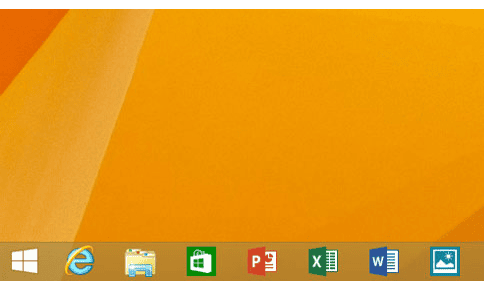
A complimentary point release to Windows 8 introduced in October 2013, Windows 8.1 marked a shift towards yearly software updates from Microsoft and included the first step in Microsoft'southward U-turn around its new visual interface.
Windows 8.1 re-introduced the Kickoff button, which brought upwardly the Start screen from the desktop view of Windows viii.ane. Users could also choose to kick direct into the desktop of Windows eight.1, which was more than suitable for those using a desktop computer with a mouse and keyboard than the impact-focused First screen.
Windows ten
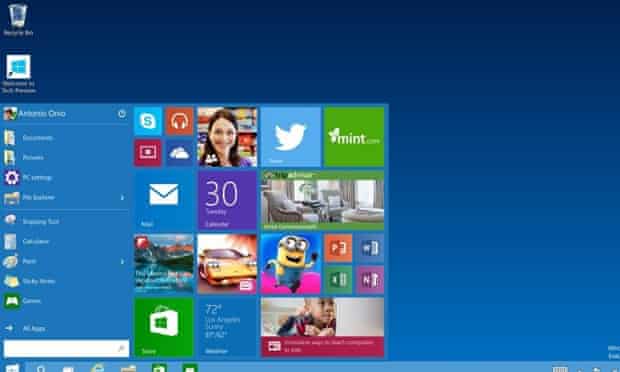
Announced on thirty September 2014, Windows x has only been released equally a test version for keen users to try. The "technical preview" is very much still a work in progress.
Windows x represents another step in Microsoft'southward U-turn, bringing back the Start menu and more residuum to traditional desktop computer users.
Some interesting features include the ability to switch between a keyboard and mouse mode and a tablet mode, for those computers like the Surface Pro iii with a detachable keyboard.
Windows 10 – despite being the 9th version of Windows – is designed to unify all Windows platforms beyond multiple devices, including Windows Phone and tablets, with universal apps that tin exist downloaded from the Windows Shop and run on all Windows devices.
It won't be available until 2015, likely after Microsoft's Build developer briefing in Apr, then for now Windows 8.1 is the latest version of Windows.
Microsoft unveils Windows x: 10 things to know
What Came After Windows Vista,
Source: https://www.theguardian.com/technology/2014/oct/02/from-windows-1-to-windows-10-29-years-of-windows-evolution
Posted by: clyburnnotle1973.blogspot.com



0 Response to "What Came After Windows Vista"
Post a Comment